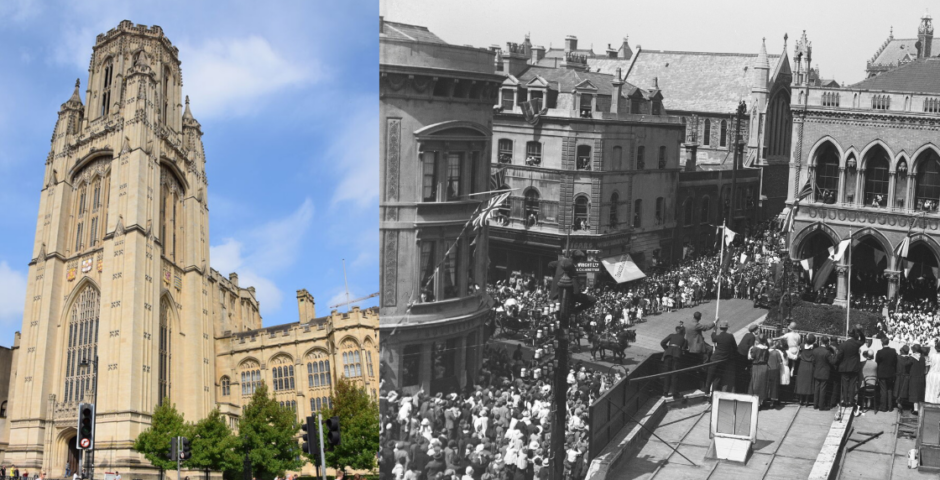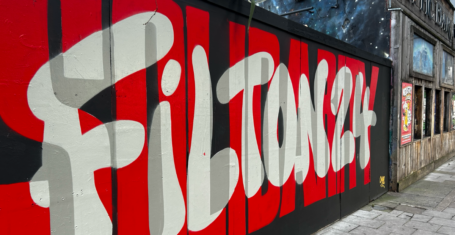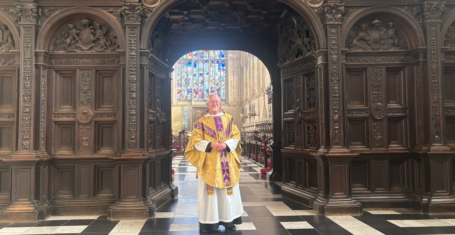
Bristol’s iconic Wills Memorial Building celebrates 100th birthday
Opened by the King and Queen in 1925, Wills Memorial’s century-long history is anything but boring
Today, on Monday 9th June 2025, the mighty 9.5-tonne bell housed in the 66-metre tower of the Wills Memorial Building will ring out across Bristol, marking 100 years since Bristol’s most iconic building first opened its grand doors.
Back in 1925, the King and Queen stood at the heart of the celebrations, greeted by thousands of Bristolians who lined Queens Road and Park Street to witness the historic event. The royal couple were handed a golden key to open the doors and became the first to sign the visitors’ book, officially opening what remains one of Bristol’s most recognisable landmarks.

Queen Mary and King George V outside the entrance of Wills Memorial Building, 9 June 1925
To commemorate this centenary, the university has commissioned a new poem by Dr. Lawrence Hoo, a poet, educator, and an advocate for anti-racism and the decolonisation of education and research. His work will reflect both the triumphs and the complexities of the building’s century-long story.
But how well do you know the Wills Memorial Building?
Built on the site of the former Bristol Blind Asylum, the Wills Memorial Building was funded by George, Henry, and Alfred Wills in memory of their father, Henry Overton Wills, the first Chancellor of the University of Bristol.
Most Read
Commissioned in 1912 and designed by Bristol architect Sir George Oatley, who was knighted the same year the building was completed, the structure stands as one of the last great Gothic secular buildings constructed in Britain. Construction began in 1915, but the outbreak of the First World War delayed progress. Ten years later, the building was finally unveiled. Over three days, tens of thousands streamed through its doors, on one day alone 30,000 visitors were recorded.

Cheering crowds during the visit of King George V and Queen Mary, Queen’s Road, 9 June 2025
During the Bristol Blitz of 1940, the tower and Great Hall sustained serious damage from an incendiary bomb. Although the tower survived, it wasn’t until 1963 that full restoration was completed.

The Great Hall following air-raid damage
In more recent years, the Wills Memorial Building has continued to serve the city in new ways. Over the past 24 years, public tours have raised more than £48,000 for The Grand Appeal, the charity supporting Bristol Children’s Hospital.
The building has also been a proud setting for countless graduations, hosting students from across the globe. Lots of famous faces have graced the halls of Wills Memorial. Among those who’ve received honorary degrees in the Great Hall are literary giants like Thomas Hardy and Terry Pratchett, actors Daniel Day-Lewis, Emily Watson, and Matt Lucas, as well as musician James Blunt and children’s author Julia Donaldson. Winston Churchill, chancellor of the University from 1929 to 1965, famously led degree ceremonies in the Great Hall when it was still damaged from the Blitz.

Queen Elizabeth II outside the Wills Memorial Building, 5 December 1958
But the Wills Memorial Building also stands as a reminder of more complex truths. In 2022, a public consultation was launched to consider the names of seven University buildings linked to families and industries historically connected to the transatlantic trade in enslaved Africans, including the Wills family. A substantial portion of their wealth came from tobacco grown on plantations worked by enslaved people.
The university’s ongoing work includes confronting this legacy with honesty and transparency. Through collaborations with staff, students, and the wider community, efforts are being made to acknowledge this history more fully and to ensure it is not forgotten.
Professor Evelyn Welch, Vice-Chancellor and President of the University of Bristol, said:
“The Wills Memorial Building has been an integral part of the student journey for generations, seeing thousands learn, grow and graduate beneath its vaulted ceilings. Its place in the city reminds us of important lessons from the University’s past, which stand together with the limitless potential of its future.”
All images courtesy of Special Collections, University of Bristol Library
Featured image via Nick Riddle



















